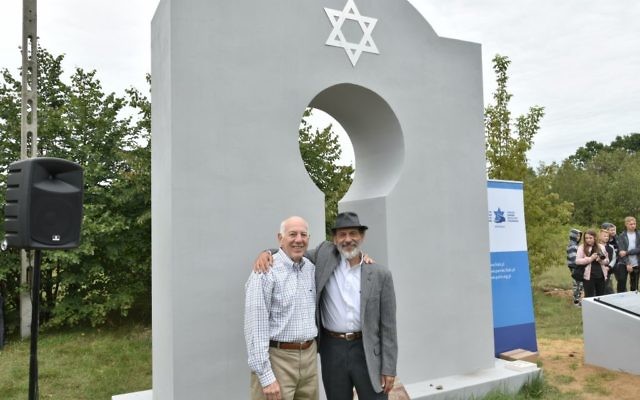Descendants Restore Polish Town’s Jewish Memory
A monument in Kaluszyn, Poland highlights atrocities of WWII for Jewish residents.

Time is a strange thing. An important idea that has gestated for years can suddenly come to fruition in a matter of days.
About 10 years ago I found out that Joe Gellman, the younger brother of a childhood friend, was trying to reclaim the Jewish cemetery in the town of Kaluszyn, Poland, home of my father. The town was one of hundreds in Poland where over 3 million Jews were taken to be murdered by the Nazis.
Kaluszyn lost more than 6,000 Jews. A handful survived, but no Jews now live there.
Joe and his family grew up in Charleston, S.C., where I was also born. His grandfather was born in Kaluszyn, just like my father.
Before World War II, Kaluszyn was a small town of under 10,000 people. About 60 percent were Jewish. Today, the town has only 3,000 residents, none of whom is Jewish; all signs have disappeared that Jews and Jewish culture once thrived there.
The Nazis flattened the town, a resistance city during the war, and used Jews as slave labor to tear down the synagogue and remove all headstones from the two cemeteries. All the rubble, with all the Jewish memories that rubble represented, was used to pave a runway nearby for the Nazi killing machine in Poland.
Perhaps that is why Joe had such an empty feeling when he visited there 10 years ago. But he decided he should do something about it.
Within months Joe had applied to the Polish government to acquire the abandoned cemetery and reclaim it through a Polish trust. His goal was to build a monument to honor the memories of those who were robbed of them in death.
For eight years I asked Joe if I could help him, and two years ago he finally agreed. Our journey to re-consecrate the cemetery property culminated Sept. 14 with the dedication of a beautiful and haunting monument.
The dedication ceremony was 78 years to the day after Kaluszyn fell to Nazi forces, which happened to be on the first day of Rosh Hashanah 5700.

In the two years leading up to the consecration, I found about 180 of the descendants of Kaluszyn and asked for their support. Joe, who now lives in Jerusalem, worked with a fellow American, also now living in Israel, to design our monument, which was built and paid for through the generosity of people in Charleston, Savannah, Atlanta, Detroit, England and other places around the world.
My travels have taken me to many countries, but I’d chosen to never visit Poland. My anxiety grew as I anticipated a Sept. 11 departure for the dedication Sept. 14. I would be visiting a forbidden place.
Then Hurricane Irma bore down on Atlanta, and I wondered whether the storm was an omen from my ancestors, warning me that I had made a mistake in supporting this project.
After some sleepless nights, I concluded that I had to go. I decided to leave early for Amsterdam to avoid Irma but refused to change my arrival in Poland because I still didn’t feel welcomed. There would be so much dark history there.
There were 13 of us in our group: some people I had talked into contributing to the project, plus Joe’s group, consisting of the designer, Ken Goldman, and his wife, Sandy, Joe’s sister and a personal friend of Joe’s.
We met in Warsaw and became fast friends. It was so strange to think that if not for all the turmoil in the world eight decades ago, we might have grown up as friends in Kaluszyn.
Before we traveled to Kaluszyn, we spent a day in Warsaw, where we took a private tour of many Jewish sites.
Photo records show that virtually everything in Warsaw was destroyed in World War II. Monuments now mark the significant spots, such as the bridge between the small and large ghetto and Mila 18. Only a fragment of the ghetto wall remains.

A beautiful museum traces Polish Jewish history and contains a wonderful replica of a small synagogue.
On the morning of the dedication, the 13 of us and about 30 other people boarded a bus for the 45-minute ride to Kaluszyn. When we arrived at the cemetery, I was pleased to see the monument standing tall and proud in the open field, the only marker in the town to show that Jews once lived there.

There were signs that today’s Jews are finding this site. Stones and yahrzeit candles already lined the base of the monument like tiny mourners standing vigil. We had done a good thing for our fellow Jews.
The ceremony was understandably emotional. More than 100 people were there, including four representatives of the U.S. government, the Israeli ambassador to Poland, the Catholic priest of the parish, the chief rabbi of Poland, a group of local people and the schoolchildren of the town.
Joe made a moving speech about the history of this community and the significance of the date of the event.
It will be one of my greatest accomplishments to have done some small part to help those departed souls rest and help those who desire to pay their respects. No visitor will have to feel the emptiness that Joe felt 10 years ago.
Of course, there are so many more communities to remember. Even within Kaluszyn, our goal is to place more markers commemorating significant Jewish sites.
Over those two days in Poland, I felt time collapse as I was drawn back to the place where my ancestors had once lived. It was joyful. It was sorrowful. One job ended, and another job began.




comments